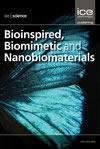草酸改性黄铁矿/壳聚糖抗菌复合材料的合成
IF 0.6
4区 工程技术
Q4 ENGINEERING, BIOMEDICAL
引用次数: 0
摘要
有机和无机成分的结合产生了具有优异性能的生物活性材料。壳聚糖是一种应用广泛的有机成分,已被公认为具有生物相容性的材料。另一方面,尽管天然存在的黄铁矿具有很强的抗菌活性,但迄今为止,它作为生物材料的暴露量有限。因此,将黄铁矿掺入壳聚糖基质有望突出黄铁矿作为生物活性材料的用途,尤其是在抗菌反应中。在本研究中,壳聚糖和草酸盐改性的黄铁矿在黄铁矿负载量为1%、3%和5%的情况下结合形成珠粒。EDX分析可以证实黄铁矿在珠粒基质中的负载量。与空白壳聚糖珠粒相比,添加黄铁矿可使珠粒的吸水率提高37%。将珠子浸入模拟体液中显示了珠子通过形成磷灰石而具有的生物活性。所有含有草酸改性黄铁矿的复合珠粒都表现出对大肠杆菌和金黄色葡萄球菌的微生物活性,尤其是含有5 wt%草酸盐黄铁矿。本文章由计算机程序翻译,如有差异,请以英文原文为准。
The synthesis of oxalate-modified pyrite/chitosan as antibacterial composite
The combination of organic and inorganic components has produced bioactive materials with excellent properties. Chitosan is a widely used organic component, which has received recognition as biocompatible material. On the other hand, naturally occurred pyrite so far received limited exposure as biomaterial, despite its great antibacterial activity. Hence, the incorporation of pyrite in chitosan matrix is expected to highlight the usage of pyrite as bioactive material, especially in antibacterial response. In this research, chitosan and oxalate-modified pyrite was combined to form beads at wt% pyrite loading of 1%, 3%, and 5%. The EDX analysis could confirm the loading of pyrite in the bead’s matrix. The beads exhibit high water absorption ability, with addition of pyrite could increase the absorption of water up to 37% compared to blank chitosan beads. The immersion of beads in simulated body fluid shows the bioactivity of beads by formation of apatite. Microbial activity against E. coli and S. aureus is exhibited for all composite beads containing oxalate-modified pyrite, especially for beads containing 5 wt% oxalate-pyrite.
求助全文
通过发布文献求助,成功后即可免费获取论文全文。
去求助
来源期刊

Bioinspired Biomimetic and Nanobiomaterials
ENGINEERING, BIOMEDICAL-MATERIALS SCIENCE, BIOMATERIALS
CiteScore
2.20
自引率
0.00%
发文量
12
期刊介绍:
Bioinspired, biomimetic and nanobiomaterials are emerging as the most promising area of research within the area of biological materials science and engineering. The technological significance of this area is immense for applications as diverse as tissue engineering and drug delivery biosystems to biomimicked sensors and optical devices.
Bioinspired, Biomimetic and Nanobiomaterials provides a unique scholarly forum for discussion and reporting of structure sensitive functional properties of nature inspired materials.
 求助内容:
求助内容: 应助结果提醒方式:
应助结果提醒方式:


